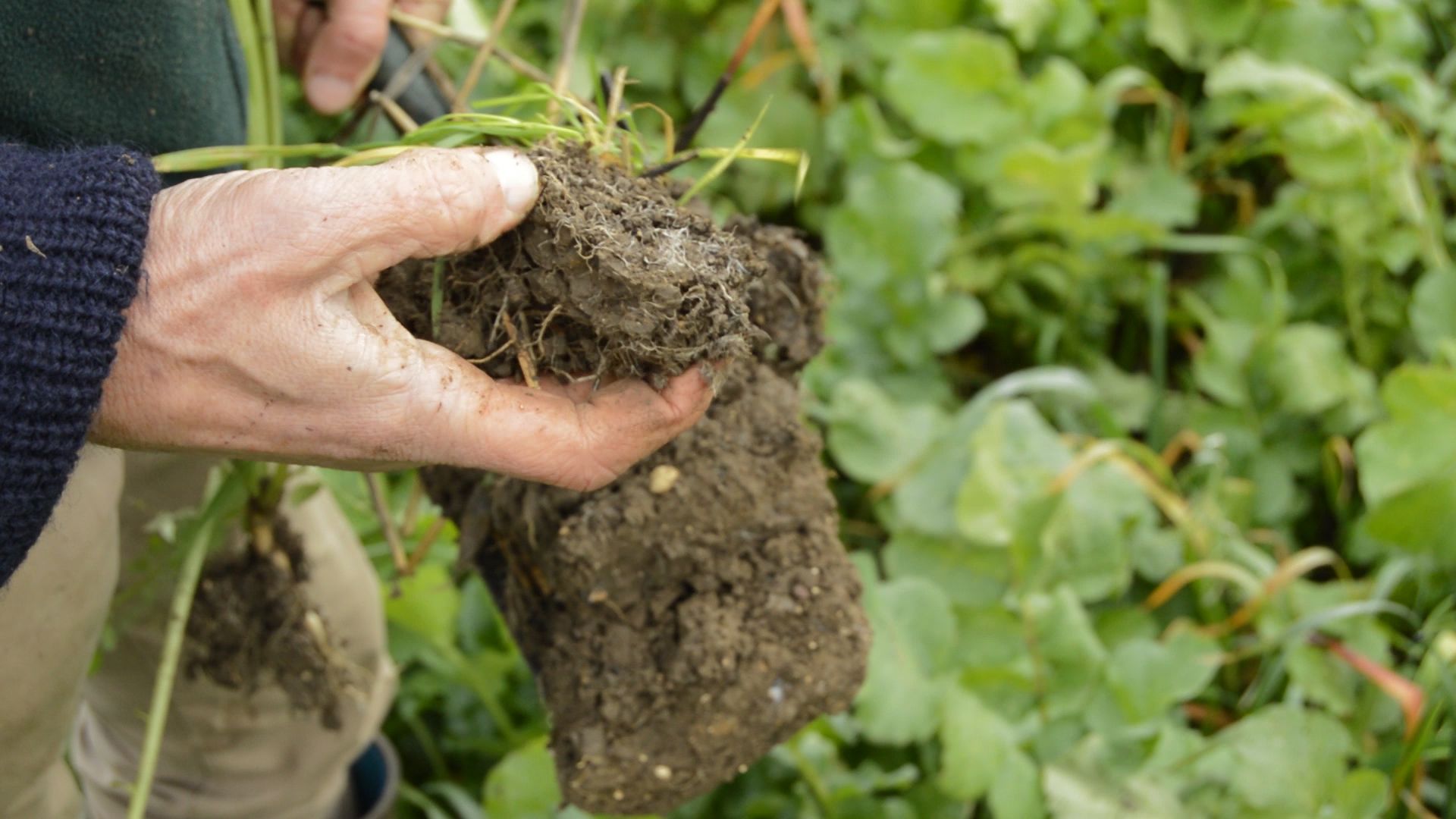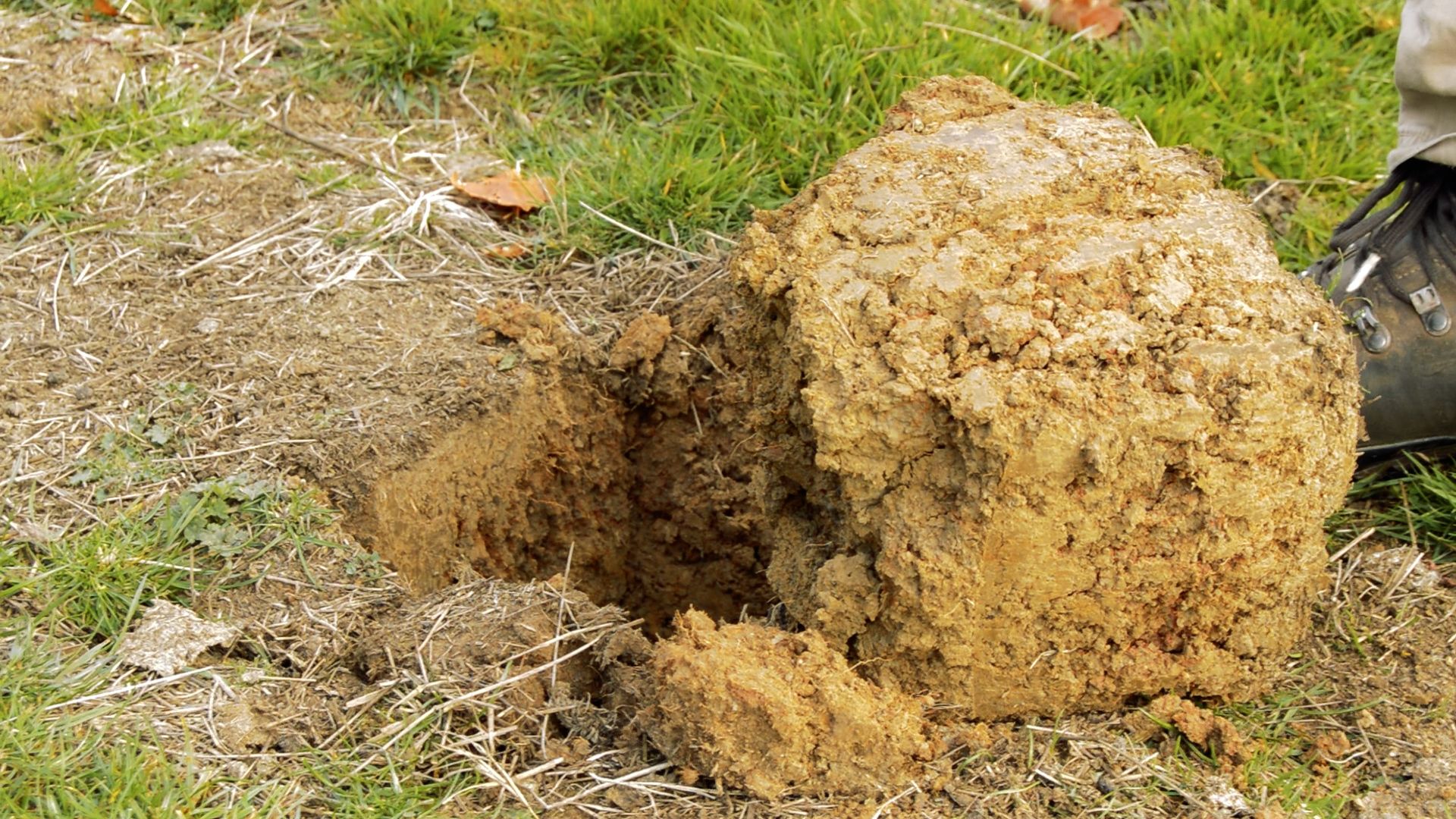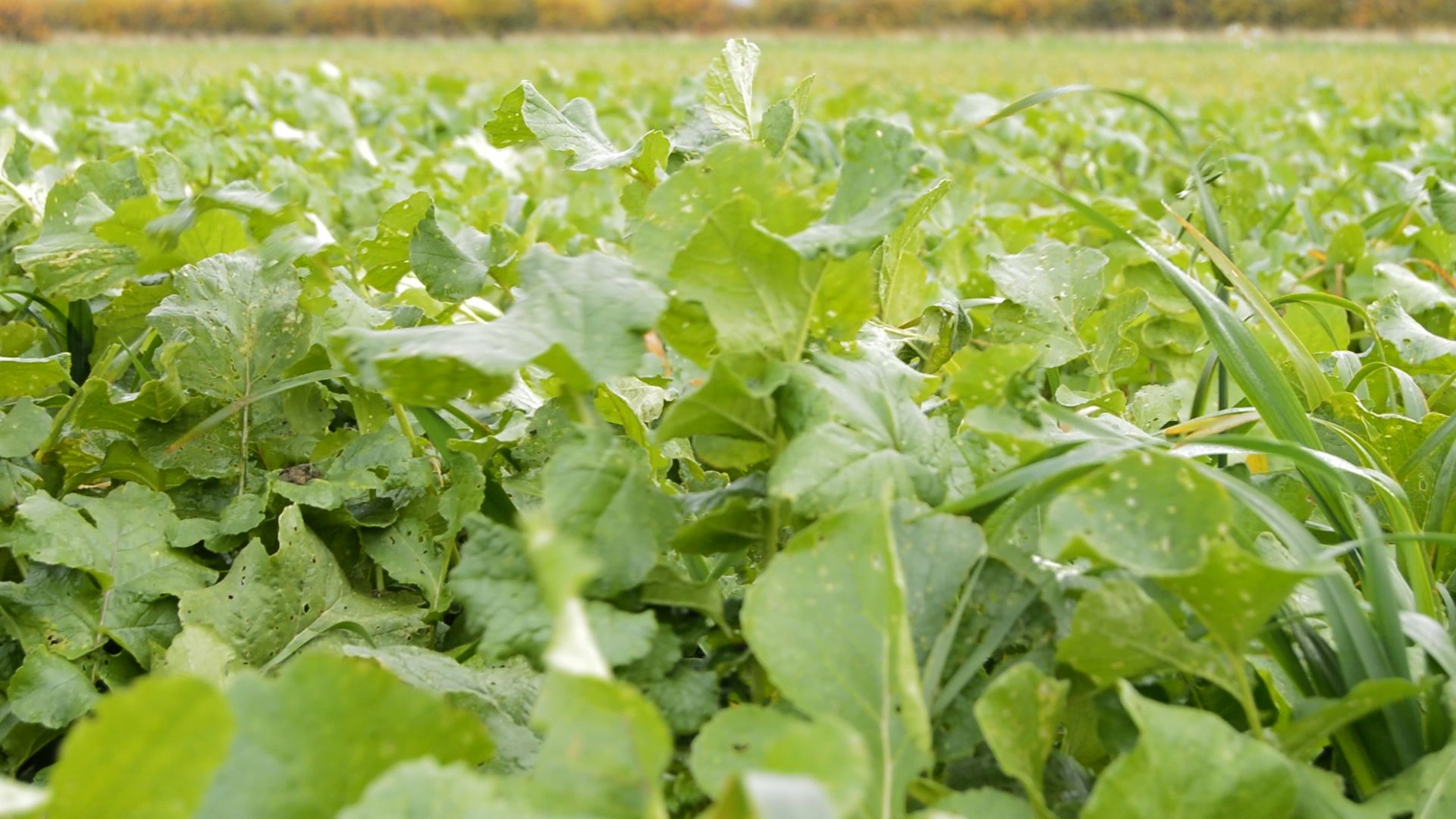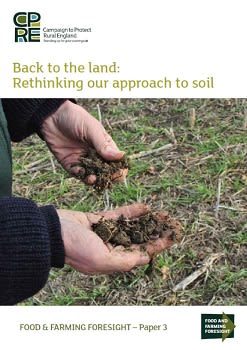The thin layer of soil covering the earth's surface is the difference between survival and extinction for most terrestrial life.

We rely for almost all of our food – 95% according to the United Nations’ Food and Agriculture Organisation (FAO) – on rainfall falling on a thin layer of soil, often only a few centimetres thick. This living planetary skin is proportionally 10,000 times thinner than our own.
But we're taking soils for granted.
Our ignorance about soil biology is profound. Soils have been abused and squandered throughout history. In our era (since the last century), the use of agricultural chemistry and the plough have become conventional in farming. This system ignores soil’s biological complexity and fails to nurture other important functions. Soils have been regarded as a resource that can last forever.
Fortunately, nature is resilient and we can, with care and skill, protect, regenerate and restore soils to health. There is an urgent need to do so.
This new report from the Campaign to Protect Rural England explores why soils are so important and sets out the key threats they face. It also tells the inspiring stories of farmers who are employing innovative solutions to bring their soils back to life.
The soil never sleeps.
Never slips into ideology or nostalgia.
It is place and purpose,
The perfection of decay.
A story that shifts
From mouth to mouth.
A crucible for rebirth.
A rooftop on another world.
Why is soil so important?
Soils support plants that provide food, fibre, fuel and much besides. They retain and release excess water, clean and filter it – removing pollutants and pathogens – to recharge underground stocks. They emit CO2 and absorb it from the atmosphere. The web of organisms in soil are a primary food source for wildlife above. Most fundamentally, soil is the ultimate digestive system, decomposing all that lived and recycling it to enable new life. Soil is both the end and beginning of life.
Varied land uses, and especially farming, have shaped the landscape but the underlying soils are fundamental to landscape and the habitats and ecosystems it supports.

The damage and loss of soil is a much-overlooked tragedy of the modern age. It is also avoidable.
Protecting the nation’s soil resources from further degradation is essential but so are reversing the trends and managing soils in ways which regenerate them to health. Healthy soils can better support our needs in terms of food, clean water and other natural benefits. But action on soils is also action on the most pressing and urgent issue of climate change.
What's happening to our soils?
Six threats to soils

Erosion
One third of UK soils are thought to be degraded , with 1 million hectares – 36% of all arable land – at risk of erosion
Removal of vegetation and disturbing the soil exposes it to the eroding agents of wind and rain. Typically, where plants are removed then the roots which help bind the soil are also destroyed: on a bare slope soil can erode up to 100 to 1,000 times faster than on a vegetated one. In UK cultivation, ploughing causes serious problems. Other causes of soil erosion include overstocking of animals, leading to overgrazing, and heather burning for game.
Compaction
The physical structure of soil affects its quality and health. Soil is generally porous, having voids filled with air and water that provide habitat for soil organisms and for plant roots to penetrate and spread. When soils are ‘mechanically stressed ’ – put under physical pressure – they can become compressed, reducing the volume of pores. The expanding size, power and weight of farm machinery has increased the risk.
Loss of soil organic matter (SOM)
Formed from once-living animal and plant matter, SOM is found in all soils and is an indicator of soil quality and health. It is vital for a range of key functions: absorbing, cleaning and storing water, storing carbon, supporting levels of micro-organisms, and contributing to soil structure. Changes in land use, such as ploughing up permanent pasture for arable crops or to ‘improve’ it usually lowers SOM.
In England and Wales the total estimated organic carbon loss from the soil each year is 5.3 million tonnes, or on average 0.6% of the existing soil carbon content



A gram of soil – about a quarter of a teaspoon – can contain one billion bacteria cells
Changes to soil biodiversity
Healthy soil hosts an incredible diversity of life from tiny, single-celled organisms like bacteria and protozoa to fungi, insects and invertebrates and animals like moles and badgers. Land management that changes the physical and chemical properties of the soil will have an impact on soil biodiversity. In farming the most damaging activities are :
• repeated disturbance by cultivation
• compaction reducing mobility of soil organisms
• adding ammonia and nitrate which acidify soil
• use of toxic agrichemicals, particularly fungicides.
Loss of peatland soils
England’s peatland areas store 584 million tonnes of carbon – or 2.14 billion tonnes of CO2.
Peat forms when land is waterlogged and vegetation breaks down more slowly so accumulates. Around 11% of England is peatland, but these areas often been under-appreciated despite their cultural significance and their unique wildlife. Burning heather exposes the peat to air and vigorous heather growth dries it further while the fire damages fragile habitats and species such as Sphagnum mosses that absorb rainfall. Peat for horticulture or for energy in the UK is removed at up to 100 times faster than it can form.
Soil damage and loss from built development
The use of undeveloped land for building has more than tripled from 5,200ha a year in the 2000s to 15,800ha (2013-2017)
Soil is a living system. Covering it with an impermeable surface such as concrete or tarmac – known as ‘soil sealing’ – prevents it functioning naturally. Sealing reduces multiple functions of non-developed land and soil to one: as an inert platform for built development. This severely restricts the land’s value as natural capital for the multiple services it can deliver. In fact, the damage to the soil goes well beyond the footprint of a building, extending to accompanying pavements, car parks and open space.



Farming practice and soil loss
Conventional farming has long been reliant on the steel plough and considerable disturbance of soils to establish crops. While this is known to disrupt soil biology and, over time, reduce organic matter, farming has depended on synthetic fertilisers to mask these effects to improve crop yields. Along with pesticides, artificial fertilisers have simplified the way land is farmed, allowing shorter rotations, often of wheat and oil seed rape.
As climate change kicks in, farmers are facing new conditions for which the traditional methods may no longer work. Cultivation and harvesting will be more difficult as weather becomes more erratic – hotter, drier summers and warmer, wetter winters are predicted. Safe working windows which avoid soil damage will be harder to identify. In this new context, harvesting winter vegetables on a specific date which retailers demand to fill shelves, or taking maize off land in late autumn can be highly damaging.
The solutions
How farmers are bringing their soils back to life

Weston Park Farms, Weston, near Stevenage, Hertfordshire
"Mother nature doesn't plough so why should we?"
Brothers John and Paul Cherry have managed the farm at Weston for over 30 years. It is a family-owned mixed farm with 800 hectares of arable crops – wheat, barley, oats, oil seed rape, beans and peas – along with beef shorthorn cattle in a 140-strong suckler herd.
In the 1970s and 80s they, like many, were enthusiastic about chasing high yields with maximum ploughing to create the finest seed bed and using plenty of fertilisers, chemicals and other additions. But over time this took its toll on their arable soils, especially when compared to the permanent pasture.
At a loss as to what to do, John visited two no till farms and had a revelation. Giving up cultivating suddenly made sense. The farm moved to a full no till system from 2010.
The benefits have been significant. With no till the brothers need fewer tractors so machinery costs are well down. Staff get to go home at 4.30pm while neighbouring farmers are working their fields day and night. They use far less fertiliser and chemicals. Yields are down and can vary but costs are down more.
But the brothers’ greatest achievement to date is to have successfully launched the first dedicated no till show and conference in the UK – Groundswell. Hosted on the farm each June, this brings together engaged and innovative farmers and scientists from across the globe to learn from each other about soils and how farming can contribute to one of the most urgent issues of our time.



Romshed Farm, Underriver, near Sevenoaks,Kent
Romshed is a 70-hectare historic farmstead sitting within the High Weald Area of Outstanding Natural Beauty. The farm was run down and buildings derelict when Fidelity Weston and her husband Martin bought it in 1984. They set about renovating and managing it with conservation and wildlife firmly in mind.
The main livestock are sheep – 150 Lleyn ewes with 200 lambs – and a herd of 60 Hereford cattle with a resident bull. All are reared on pasture and wildflower-rich forage and spend as much of their lives outdoors as conditions allow. Organic conversion meant the farm stopped using nitrate fertiliser. Around 40% of the land now has 15-40 species per square metre, a level usually only seen in unimproved grassland.
Visits to two farms in Kent inspired Fidelity to trial mob grazing at Romshed from autumn 2017. Cattle are now moved regularly every one to four days from paddock to paddock to fresh grass and managed with a lightweight electric fence.
Romshed Farm produces high quality food sustainably for a good price – and it has cut its costs. It is supporting good soils, rich conservation pastures and beautiful landscape. These should all stand the farm in good stead for the changes in farming policy and funding ahead. But the ideal for Fidelity would be a market which recognises pasture-fed and rewards farmers for doing what is good for the land, the livestock and the people who are fed by them.



Other innovative solutions to reduce the degradation of soils include:
- Agroforestry - bringing together arable crops or pasture with trees that are harvested for timber, fuel and fruit to harness the benefits of farming and forestry and the synergies between them.
- Paludiculture - the productive use of wetland areas in ways that preserve their peat.
Find out more about these solutions and read more case studies in the full report.
Find out more about these solutions and read more case studies in the full report.
UK soils store around 10 billion tonnes of carbon or the equivalent of 70 years of annual UK greenhouse gas emissions

What should be done?
The analysis in this report shows that soils are fragile and face significant pressures. It also suggests innovative approaches exist that can safeguard these natural assets while delivering the needs of society that so depend upon them. This section makes a series of recommendations to government to support the scaling-up of those approaches and to strengthen the policies and tools that are being developed.
1. Revise the 25 Year Environment Plan to make protection of all soils from degradation a headline goal with an action plan to achieve sustainable management by 2030
2. Bring forward new measures to achieve net zero emissions from agricultural land and other land uses by 2050
3. Under the new agricultural policy design a new package of public investment and regulation to halt soil degradation and promote measures which protect and regenerate soils
4. Commit to developing and resourcing the comprehensive evidence base, metric/indicators and monitoring processes needed to underpin sustainable management and effective protection of soils
5. Revise the NPPF and national planning guidance to fully recognise land and soils as critical natural capital and for vital ecosystem services and to minimise their avoidable degradation
Leadership is vital in both farming and land development as well as working in partnership with government to make change happen. We believe these proposals can contribute to delivering the ambitious transformation needed to protect, restore and regenerate the nation’s soils.
This report presents a number of approaches, primarily led by farmers, which offer workable solutions to the problems soils face. They also address much wider issues, including keeping carbon in the soil where it can drive healthier soil ecosystems to produce food. These in turn offers farmers ways to harmonise managing their land to produce food and a rewarding living and vocation as well as sustaining nature.
This report urges the government to put soils at the centre of its environmental policies, to halt their degradation and support their protection and restoration. This means integrating sustainable use of land across government, including optimising the use of land for all development of homes, infrastructure and industry. It also means setting farming on a twin but parallel track towards being sustainable and producing low and ultimately no net carbon emissions.
Click here to read the full report
Click here to read the full report


We are CPRE, the countryside charity. We want a thriving, beautiful countryside for everyone.
Be a part of what we stand for
Did you know that we work across a huge range of areas including urban regeneration, public transport and recycling? Becoming a member is your way to connect to the countryside and promote progress and protection for our rural, areas, from moors to fells, quiet valleys to busy cycle paths.
And as well as doing your bit to protect the countryside, you’ll receive some great perks as a CPRE member. It’s our way to say thank you for standing up for the countryside with us.
Or visit our website to find out more about our work and how to get involved.


